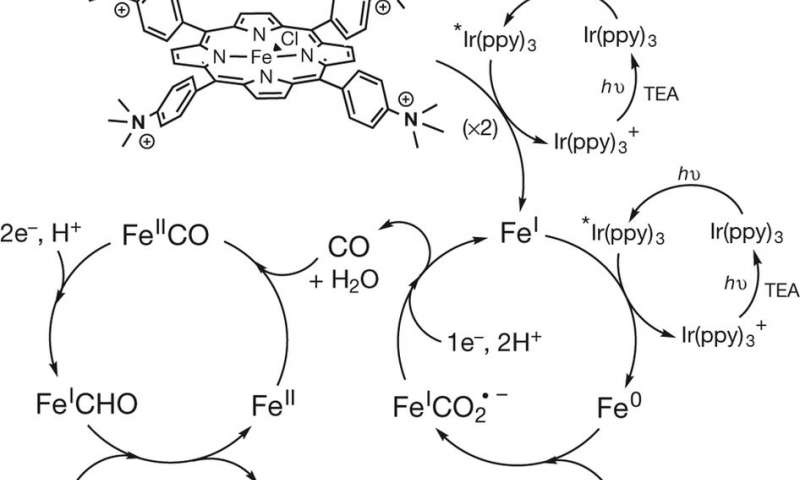博文
Nat.:铁催化+阳光将CO2转化为甲烷
 精选
精选
|||
Nat.:铁催化+阳光将CO2转化为甲烷
诸平
前文介绍了将CO2转化为碳纳米管的新技术——清理CO2排放可创造价值数十万亿美金的利润。本文再介绍来自《自然》(Nature)杂志网站的另一则新成果。法国(Université Paris Diderot)和阿根廷(Universidad Nacional de Córdoba, Argentina)的研究人员合作,利用铁配合物(作为催化剂)和太阳光可以将CO2转化为甲烷。详见Heng Rao, Luciana C. Schmidt, Julien Bonin, Marc Robert. Visible-light-driven methane formation from CO2 with a molecular iron catalyst. Nature, 2017, DOI: 10.1038/nature23016.图1就是来自《自然》杂志发表的论文中利用铁化合物(作为催化剂)和太阳光可以将CO2转化为甲烷机理图示。

Fig. 1 Sketch of the proposed mechanism for CO2 reduction to CH4 by catalyst 1. Credit: Nature (2017). DOI: 10.1038/nature23016
来自法国巴黎狄德罗大学(Université Paris Diderot)和来自阿根廷的科尔多瓦国立大学(Universidad Nacional de Córdoba)研究人员合作,已经发现了一种可以用来将CO2转换成甲烷的化学反应过程。他们的论文于2017年7月17日已在《自然》杂志网站上发表,该研究小组描述了他们的技术是怎样工作的以及他们对其进行改进的一些想法。
随着人类的活动持续不断地向大气中引入CO2,导致全球变暖,世界各地的科学家寻求替代方法来减少CO2气体的排放,并设法降低大气中已经存在的CO2含量。在法国和阿根廷科学家联合完成的这项新研究中,研究人员已经开发出一种化学过程,此化学过程具有一箭双雕的作用,不仅可以减少CO2排放,同时也可以降低现有大气中CO2的水平,使其转化为可以作为绿色能源使用的甲烷。
此技术涉及到对于CO2乙腈(CH3CN)溶液的照射,CH3CN具有可以提供的单电子,一种光敏剂和一种四苯基铁卟啉配合物(iron tetraphenylporphyrin)催化剂。此铁配合物是用四苯基卟啉基团功能化的一种配合物。被阳光照射持续几个小时,此过程会导致甲烷(CH4)、CO及H2产生。
研究人员承认,这个过程是非常低效的,因为生产的产品中实际上CO含量占82%。而且此过程也非常慢,产生CH4的速度为12 g/h。但是该研究团队认为,使用修改后的两步过程即可得到更高效率。研究人员指出,他们还使用纯洁的CO2进行了相关研究。研究团队还计划更好地了解在反应过程中实际究竟发生了什么反应,他们知道在此过程的第一步就是铁与CO2结合,但它究竟是如何发生加氢反应的仍然并不清楚。更多信息请注意浏览原文或者相关报道
Converting carbon dioxide to methane using iron and sunlight
New photocatalyst speeds up the conversion of carbon dioxide into chemical resources
Abstract
Converting CO2 into fuel or chemical feedstock compounds could in principle reduce fossil fuel consumption and climate-changing CO2 emissions. One strategy aims for electrochemical conversions powered by electricity from renewable sources, but photochemical approaches driven by sunlight are also conceivable. A considerable challenge in both approaches is the development of efficient and selective catalysts, ideally based on cheap and Earth-abundant elements rather than expensive precious metals. Of the molecular photo- and electrocatalysts reported, only a few catalysts are stable and selective for CO2 reduction; moreover, these catalysts produce primarily CO or HCOOH, and catalysts capable of generating even low to moderate yields of highly reduced hydrocarbons remain rare. Here we show that an iron tetraphenylporphyrin complex functionalized with trimethylammonio groups, which is the most efficient and selective molecular electro- catalyst for converting CO2 to CO known, can also catalyse the eight-electron reduction of CO2 to methane upon visible light irradiation at ambient temperature and pressure. We find that the catalytic system, operated in an acetonitrile solution containing a photosensitizer and sacrificial electron donor, operates stably over several days. CO is the main product of the direct CO2 photoreduction reaction, but a two-pot procedure that first reduces CO2 and then reduces CO generates methane with a selectivity of up to 82 per cent and a quantum yield (light-to-product efficiency) of 0.18 per cent. However, we anticipate that the operating principles of our system may aid the development of other molecular catalysts for the production of solar fuels from CO2 under mild conditions.
https://blog.sciencenet.cn/blog-212210-1067524.html
上一篇:清理CO2排放可创造价值数十万亿美金的利润
下一篇:Nat.:科学家在地球上观察到重力异常